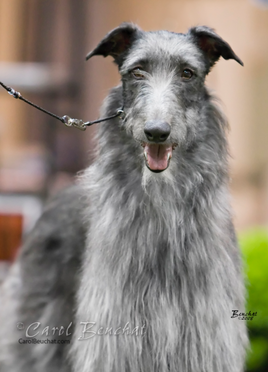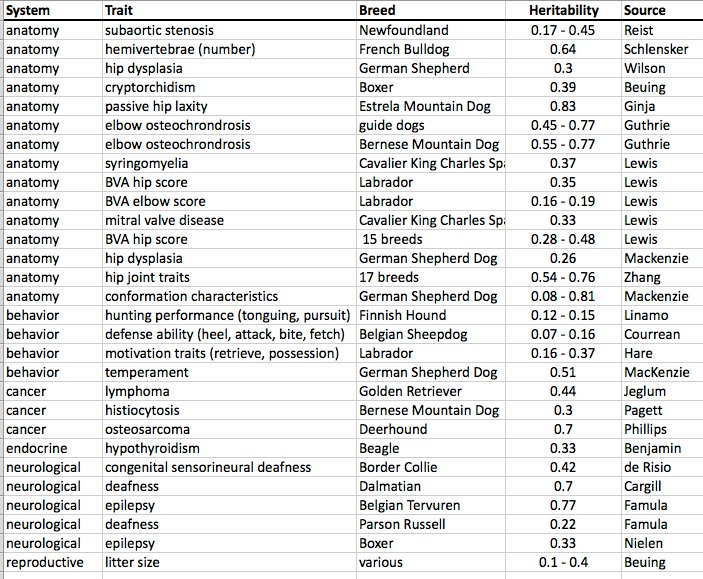| If we can't look to the molecular geneticists for solutions, then we must go back to basic principles of inheritance and the science of animal breeding for help. We know that osteosarcoma is highly heritable. In Scottish Deerhounds, the heritability of osteosarcoma is 0.7, which means that 70% of the variability in the occurrence of the cancer in Deerhounds can be attributed to genetics. The other 30% we attribute to "environment", our catch-all term for everything that is "not genetic". (If a trait has no genetic basis, heritability is 0%; if the trait is entirely determined by genes, then heritability is 100%.) The higher the heritability of a trait, the easier it is to change the frequency of the phenotype in the population by selection. A heritability of 70% for osteosarcoma in Deerhounds means that a selection program can be very effective in reducing the incidence of the disease in the breed. And the most efficient way to run such a selection program is not by selecting against the phenotype directly, but by using information about the breeding value of each dog for the trait. |
Heritabilities of Various Traits in Dogs
With no hope of a genetic test anytime soon for osteosarcoma in dogs, breeders should be able to significantly reduce the incidence of this cancer in their breed by using estimated breeding values. This requires only a pedigree database and the information about affected animals among a dog's relatives. A computer generates a number that reflects the "genetic value" of a dog for a particular trait, in this case osteosarcoma. By using this estimated breeding value (EBV) to identify dogs at lower risk for osteosarcoma, breeders can efficiently reduce the incidence of this cancer in the breed.
The real beauty of EBVs is that you don't need to know the genes involved in a trait or how it is inherited. You don't need to base selection decisions on a phenotype that might be only partially determined by genetics. The estimated breeding value is a numerical estimate of the what an animal will produce in its offspring.
EBVs can be used to improve selection against many genetic disorders. Heritability of other cancers are also relatively high: lymphoma in Golden Retrievers has a heritability of 44%, and histiocytosis in Bernese Mountain Dogs is 30%. Heritability of hypothyroidism in Beagles is 33%, mitral valve disease in Cavaliers is 33%, and epilepsy in Belgian Tervuren is 77%.
When a disorder pops up in a breed, breeders usually rush to identify the responsible gene so they can develop a test and select against. However, for many disorders a test is not likely to be forthcoming - not soon, and maybe not ever. Estimated breeding values offer a way to select against a problem much more efficiently than using phenotype alone, and all you need is a health database.
Several kennel clubs are already providing EBVs to breeders for hips (e.g., Finland and the UK), and these resources will continue to develop for other disorders. A website that will provide EBVs for hip and elbow dysplasia for dogs in the US based on the public data in the OFA database is in the works at Cornell, and ICB will be working with several groups of breeders in 2015 to get their data online and train them how to use it. For breeders that have been struggling to manage genetic disorders, sometimes for decades, we should be able to start seeing improvement soon if breeders will use it.The website is under development, but you can have a look here.
We will have an EBV course available online sometime in the next few months, but if there is a group in your breed that is interested in getting in on the initial stage of training and implementation of EBVs, please contact ICB and we can discuss what would be involved.
ICB's Population Genetics course lays the foundation for understanding how EBVs can be used as part of a strategy for managing genetic disorders in purebred dogs. The next class starts 5 January.
Benjamin SA, LC Stephens, BF Hamilton, WJ Saunders, AC Lee, GM Angleton, & CH Mallinckrodt. 1996. Associations between lymphocytic thyroiditis hypothyroidism, and thyroid neoplasia in Beagles. Vet Pathol 33: 486-494.
Beuing R, N Janssen, & H Brand. Analysis of fertility in canine populations in respect to genetic and environmental influences. (MS)
Beuing R, G Beuing, P Pracht, & N Janssen. 2003. Cryptorchidism in dogs: prevention by breeding. Icelandic Sheepdog meeting; powerpoint presentation.
Cargill EJ, TR Famula, GM Strain, & KE Murphy. 2004. Heritability and segregation analysis of deafness in US Dalmatians. Genetics 166: 1385-1393.
Courreau J-F & B Langlois. 2005. Genetic parameters and environmental effects which characterize the defence ability of the Belgian shepherd dog. App Anim Behav Sci 91: 233-245.
De Risio L, T Lewis, J Freeman, A de Stefani, L Matiasek, & S Blott. 2010. Prevalence, heritability and genetic correlations of congenital sensorineural deafness and pigmentation phenotypes in the Border Collie. Vet J 188: 286-290.
Famula TR, EJ Cargill, & GM Strain. 2007. Heritability and complex segregation analysis of deafness in Jack Russell Terriers. BMC Vet Res 3: 31.
Famula TR, AM Oberbauer, & KN Brown. 1997. Heritability of epileptic seizures in the Belgian Tervuren. J Small Anim Prac 38: 349-352.
Ginja, MMD, AM Silvestre, AJA Ferreira, JM Gonzalo-Orden, MA Orden, P Melo-Pinto, MP Llorens-Pena, & J Colaco. 2008. Passive hip laxity in Estrella Mountain Dog- distraction index, heritability and breeding values. Acta Vet Hungarica 56: 303-312.
Guthrie S & HG Pidduck. 1990. Heritability of elbow osteochondrosis within a closed population of dogs. J Small Anim Pract 31: 93-96.
Hare E & SG Thomas. 2009. Heritability of motivation-related traits in Labrador Retriever detector dogs. J Vet Behav 4: 238-239.
Jeglum KA & TR Famula. Heritability and segregation analysis of lymphoma in Golden Retrievers. (MS)
Karlsson EK, S Sigurdsson, E Ivansson, R Thomas, and others. 2013. Genome-wide analyses implicate 33 loci in heritable dog osteosarcoma, including regulatory variants near CDKN2A/B. Genome Biol 14: R132.
Leighton EA. 1999. Using estimated breeding values to reduce the incidence of genetic diseases in dogs.
Lewis TW, SC Blott, & JA Woolliams. 2013. Comparative analyses of genetic trends and prospects for selection against hip and elbow dysplasia in 15 UK dog breeds. BMC Genetics 14 :16.
Lewis TW, JJ Ilska, SC Blott, JA Wooliams. 2011 Genetic evaluation of elbow scores and the relationship with hip scores in UK Labrador retrievers. Vet J 189: 227-233.
Lewis T, C Rusbridge, P Knowler, S Blott, & JA Wolliams. 2010. Heritability of syringomyelia in Cavalier King Charles Spaniels. Vet J 183: 345-347.
Lewis T, S Swift, JA Wolliams, & S Blott. 2011. Heritability of premature mitral valve disease in Cavalier King Charles Spaniels. Vet J 188: 73-76.
Liinamo A-E, L Karjalainen, M Ojala, & V Vilva. 1997. Estimates of genetic parameters and environmental effects for measures of hunting performance in Finnish Hounds. J Anim Sci 75: 622-629.
Mackenzie SA, EAB Oltenacu, & E Leighton. 1985. Heritability estimate for temperament scores in German Shepherd Dogs and it's genetic correlation with hip dysplasia. Behav Gen 15: 475-482.
Nielen L, J Nielen, LLG Janss, & BW Knol. 2001. Heritability estimations for dieases, coat color, body weight, and height in a birth cohort of Boxers. Am J Vet Res 62: 1198-1`206.
Padgett GA, BR Madewell, ET Kellert, L Jodar, & M Parkard. 1995. Inheritance of histiocytosis in Bernese Mountain Dogs. J Small Anim Practice 36: 93-98.
Phillips JC, B Stephenson, M Hauck, & J Dillberger. 2007. Heritability and segregation analysis of osteosarcoma in the Scottish Deerhound. Genomics 90: 354-363.
Reist S. 2008. Inheritance of subaortic stenosis of the Newfoundland.
Schmutz SM & JK Schmutz. 1998. Heritability estimates of behaviors associated with hunting in dogs. J Heredity 89: 231-237.
Wilson BJ, FW Nicholas, JW James, CM Wade, I Tammen, HW Raadsma, K Castle, & PC Thompson. 2012. Heritability and phenotypic variation of canine hip dysplasia radiographic traits in a cohort of Australian German Shepherd Dogs. PLoS ONE 7: e39620.
Verryn SD & JMP Geerthsen. 1987. Heritabilities of a population of German Shepherd Dogs with a complex interrelationship structure. Theor Appl Gen 75: 144-146.
Zhang Z, L Zhu, J Sandler, SS Friedenberg, and others. 2009. Estimation of heritabilities, genetic correlations, and breeding values of four traits that collectively define hip dysplasia in dogs. Am J Vet Res 70: 483-492.
You can learn more about the genetics of dogs in ICB's online courses.
*** Online course "Population Genetics for Dog Breeders" starts 5 January ***
Visit our Facebook Groups
ICB Institute of Canine Biology
...the latest canine news and research
ICB Breeding for the Future
...the science of animal breeding



